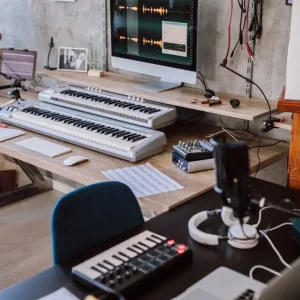Ever been to a concert and felt the room shake as the brass instruments roared to life? Or perhaps you’ve sat in awe, mesmerized by their shiny allure and booming voices. What about looking at a brass instruments list?
You’re probably wondering, “Which brass instrument should I pick up?” A fair question given the vast array within this family – from trumpets that play piercing high notes, trombones with slides producing velvety smooth melodies, or tubas rumbling like thunder.
This is where our brass instruments list comes into play. We’ll guide you through the labyrinth of brass choices. From beginner-friendly options like BB trumpet to advanced players’ favorites such as the cornet and even unique gems like French hunting horn; there’s something for everyone here.
Brass Instruments For Advanced Players
Embarking on a musical journey with brass instruments is thrilling, but some are tougher nuts to crack. The French Horn and the Baritone Horn top this list.
The French Horn
The French horn, an elegant member of the brass family, poses unique challenges. With its deep cup mouthpiece and long coiled metal tube ending in a flared bell, it’s no easy feat.
Hitting correct partials can be tough due to its conical bore design. In fact, among all brass instruments, hitting these precise notes demands meticulous skill on a single horn or even double horn. And let’s not forget about mastering complex slide positions.
The Flugelhorn
Another intriguing choice for advanced players is the flugelhorn. It presents similar challenges as trumpets because they both belong to ancient families of wind instruments crafted out of animal horns or simple metal tubes such as copper or bronze.
In fact, it’s even considered one of those “trumpet-like” brass pipes due to their close resemblance with each other physically and sonically.
However, the flugelhorn’s conical bore gives it a mellower sound than the trumpet. This means you can play melody lines that are smoother and richer in tone – something every advanced player would love to achieve.
The Wagner Tuba
The Wagner tuba is a real standout in the brass family. Richard Wagner invented this unique instrument just for his epic four-opera series “Der Ring des Nibelungen”. This fascinating creation beautifully merges features of both horns and tubas.
Famed for its rich tonal quality that resonates through orchestras worldwide from Duke Ellington’s jazz band to symphony orchestras – the rewards outweigh the hurdles.
The Baritone Horn
The Baritone Horn is a versatile yet difficult-to-master instrument that offers both tenor and bass ranges making it one heck of an exciting ride for musicians brave enough to tackle it. Its large size and weight require substantial breath control and physical endurance while the playing style has intricacies aplenty.
Bass trombone players also face similar struggles like producing sound across varied registers using different tuning slides which isn’t child’s play at all.
Now you might wonder why anyone would pick up such hard-to-play instruments. But ask any accomplished musician and they’ll tell you nothing beats basking in the glory of having mastered one of these tough brass beauties. And, we at Sloan School of Music are always ready to help you conquer any musical challenge that comes your way.
Key Takeaway:
Embarking on the brass instruments journey is thrilling, but some pose unique challenges. The French Horn and Baritone Horn top this list due to their complex structures and intricate playing styles.
Mastering them demands meticulous skill, substantial breath control, physical endurance, and an understanding of varied registers using different tuning slides. Although they may seem daunting at first glance, there’s nothing quite like the joy that comes from finally mastering these challenging yet rewarding instruments.
Brass Instruments for Intermediate Players
When it comes to brass instruments, there’s a sweet spot where challenge meets attainability. In this realm lie the alto horn and the piccolo trumpet.
The Alto Horn
The alto horn, often found in jazz bands, is a standout member of the brass family due to its cylindrical bore and cup-shaped mouthpiece. This setup allows for an enchanting blend of warmth and clarity in sound production.
In spite of being smaller than many other members in its family, don’t be fooled into thinking that mastering it will be smooth sailing. While playing it might seem like navigating calmer waters compared to more difficult brass instruments, remember that every instrument presents unique challenges.
To create music with an alto horn requires precise control over your breath and lips – much akin to whistling while trying not to blow out a candle. Achieving this balance can indeed pose quite some difficulty for learners.
A higher register means reaching those notes requires extra effort too. These are also the notes which give your melody that beautiful sparkle. So make sure you’re up for hitting those high notes when they come calling during your performance.
The Piccolo Trumpet
Another intermediate-level challenger from our list is none other than one of the smallest members – yet surprisingly demanding – members: the piccolo trumpet.
This little titan takes center stage among its peers by having two separate lead pipes each designed for different keys (B-flat/A). Yes — two. So, as you can guess, mastering it means double the work.
While smaller in size and having a higher range than most brass instruments might make this one seem like an easy pick for beginners, be warned. Its compact design brings unique challenges of its own.
Improving your embouchure, or how you position your mouth on the instrument, is crucial. You’ll need to focus more on this aspect.
Key Takeaway:
Exploring intermediate brass instruments like the alto horn and piccolo trumpet can be an exciting challenge. Mastering the warm, clear sound of the alto horn requires breath control similar to whistling without blowing out a candle.
The petite but powerful piccolo trumpet has two lead pipes for different keys, requiring double effort but offering twice satisfaction. Regardless of your choice, remember that both these instruments will stretch your musical skills and open up new horizons in your journey toward becoming a seasoned musician.
Brass Instruments for Beginners
If you’re beginning your musical experience, selecting the right instrument is essential for success. For those drawn to brass instruments, let’s explore some of the easier ones to learn.
The BB Trumpet
With its long pipes and large bell, the Bb trumpet is often a top choice for beginners. Its modern design allows learners to produce sound without much struggle. However, reaching that upper register will require good breath control and strength in your embouchure – that’s how you shape your mouth when playing.
Aiming for higher notes might seem like climbing Mount Everest at first. But with regular practice on this easiest brass instrument, it’ll become second nature before you know it.
The Tuba
You may be surprised but yes – despite being one of the largest members of the brass family with really long pipes (we’re talking 18 feet here), tubas are actually quite beginner-friendly. The wide tubing gives it a deep resonant tone while its sizeable mouthpiece makes producing sounds relatively easy even for newbies.
This big boy lets players create low-pitched melodies which not only sounds awesome but also feels incredibly satisfying. Don’t get too carried away though as maintaining a consistent pitch still needs concentration and skillful control over air pressure.
The Cornet
The cornet might look similar to a trumpet – both have conical bores leading into flared bells – yet they aren’t identical. Cornets usually play pitches in B flat (just like trumpets) but are a bit shorter and more compact, making them easier to handle, especially for younger learners.
These little powerhouses have the ability to produce soft melodies as well as peppy tunes which makes them versatile and great fun. However, it’s important to remember that despite their size, they still require strong breath control.
The Trombone
Among the various brass instruments, the trombone stands out for its unique characteristics and playing style. It is a mid-range instrument known for its rich, full tone and distinctive slide mechanism.
The trombone is larger than many other brass instruments with a long cylindrical tube that extends into a flared bell at one end. The most distinguishing feature of this instrument is its telescoping slide which can change pitch by altering the length of tubing available to vibrate.
A standard trombone has seven positions on the slide – each position changes the pitch by half-step increments. The range of notes achievable depends on both the player’s skill level and the specific model of the trombonist’s horn.
Key Takeaway:
Starting your musical journey with brass instruments? The bb trumpet, tuba, cornet, and trombone are excellent choices for beginners. These instruments offer a mix of easy playability and unique sound production that’ll make learning fun.
Remember though – mastering any instrument requires consistent practice and good breath control.
Unique Brass Instruments
No brass instruments list would be complete without a list of the most diverse pieces. These unique pieces have shaped music across centuries and cultures. We’re going to delve into some less common but utterly fascinating members of the brass family.
The French Hunting Horn
Born from animal horns used in ancient hunting rituals, the French hunting horn, or ‘cor de chasse’, holds an esteemed place in musical history. This instrument stands out for its long u-shaped pipes bent into a circular shape, enabling players to produce varying pitches by adjusting their lip tension on the mouthpiece.
Unlike modern brass instruments which rely on valves for note changes, this hand-held marvel uses natural harmonics (or overtones) for pitch variations. It’s no easy feat though. Mastering it requires not only skilled lips but also precise control over breath and tongue placement.
The Serpent
No list of unique brass would be complete without mentioning the serpent – so named because of its oblong shape resembling our slithery friends. This 16th-century invention boasts an extra valve than most other brass cousins and uses finger holes like woodwinds.
A defining feature is its conical bore—shaped like a cone—which contributes significantly to producing warm yet robust sounds perfect for church music settings back then. But don’t let this seemingly odd fusion fool you; learning to play this contraption can pose quite a challenge due to complex fingering patterns.
The Ophicleide
The ophicleide is an extinct member of the brass family invented in the 19th century as an improvement over its ancestor – the serpent. What sets it apart is the way it’s played – like a saxophone or bassoon instead of being held with both hands as other brass instruments are. It has keys operated by the left hand while your right arm supports its weight.
And if you’re curious about this unique instrument design, don’t hesitate to explore more. Its distinctive features might just ignite a new passion for music in you.
Key Takeaway:
Dive into the captivating world of brass instruments, from the timeless French hunting horn to the mysterious serpent and distinctive ophicleide. These aren’t your everyday trumpets or trombones; each instrument boasts a rich history and offers its own unique hurdles for musicians.
Discover their unique sounds, designs, and ways of playing – you never know, they might just spark your inspiration.
Which On This Brass Instruments List Will You Try?
Exploring the vast world of brass instruments takes us from the highest notes of the piccolo trumpet to the deep resonance of the tuba, every instrument has its unique character.
Each brass instrument presents different challenges and rewards. The French horn might seem daunting with its wide variety of sounds while BB trumpet could be a more friendly start for beginners.
The cornet demands endurance from advanced players whereas intriguing options like French hunting horn keep us excited about this musical journey.
This brass instruments list serves as your roadmap in navigating through these choices and uncovering their distinct charm and roles in various music genres.
When you’re ready to learn from the best, contact Sloan School of Music. We offer lessons and high-quality musical equipment for your needs.
And if you’re looking for a Brass instrument to buy or rent, visit our shop!








